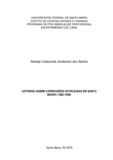| dc.creator | Santos, Nastaja Cassandra Zamberlan dos | |
| dc.date.accessioned | 2019-12-05T21:28:23Z | |
| dc.date.available | 2019-12-05T21:28:23Z | |
| dc.date.issued | 2019-06-07 | |
| dc.identifier.uri | http://repositorio.ufsm.br/handle/1/19112 | |
| dc.description.abstract | In 1885, with the arrival of the rails in the city of Santa Maria RS, the economic and social scenario began a new reality. Due to its geographical position, Santa Maria became a reference, acting as a place for people buying and traveling. Considered an important railway track, the railway station was responsible for the core of the urban movement. From this context, this dissertation aims to verify, through a historical, documentary and photographic approach, the hotel developments in the period related to the end of the 19th century and beginning of the 20th century. The creation of a blog as a Professional Master’s Degree product, corroborates the rescue of memories and identities of the city. As specific objectives, this study aimed the identification of the main hotels in the period corresponding to 1882 to 1930, as well as their location, period of ascension and end of these means of lodging. The methodology consisted of researches in newspapers of the time, as well books on local history. Another instrument used was oral history, a tool of great importance in the research, in which testimonies of former railway historians and other interviewees recall the past of the city through semi-structured interviews. In addition, snowball sampling was used, in which interviews with social actors whose characteristic is the initial participants indicate new participants, which, in turn, indicate new participants and so on until it is reached the proposed goal – the “saturation point” –, that is reached when the new interviewees begin to repeat the contents already obtained in previous interviews, without adding new relevant information. Based on theoretical references such as Cultural Patrimony, Tourism and Hospitality, Memory and Hospitality, this study proposes to be a remembrance exercise to identify and map the old hotels of Santa Maria, a city located in the Central Region of RS. Eventually, a blog (product) was prepared to offer cultural information retrieved in the study, distributed in small posts and supported with photographs. | eng |
| dc.language | por | por |
| dc.publisher | Universidade Federal de Santa Maria | por |
| dc.rights | Attribution-NonCommercial-NoDerivatives 4.0 International | * |
| dc.rights.uri | http://creativecommons.org/licenses/by-nc-nd/4.0/ | * |
| dc.subject | Meios de hospedagem | por |
| dc.subject | Memória | por |
| dc.subject | Patrimônio | por |
| dc.subject | Viação férrea | por |
| dc.subject | Registro histórico | por |
| dc.subject | Means of lodging | eng |
| dc.subject | Memory | eng |
| dc.subject | Patrimony | eng |
| dc.subject | Railway track | eng |
| dc.subject | Historical record | eng |
| dc.title | Leituras sobre expressões hoteleiras em Santa Maria (1882-1930) | por |
| dc.title.alternative | Revisiting hotels histories in Santa Maria (1882-1930) | eng |
| dc.type | Dissertação | por |
| dc.description.resumo | Em 1885, com a chegada dos trilhos no município de Santa Maria RS, o cenário econômico e social inicia uma nova realidade. Devido à sua posição geográfica, Santa Maria se torna uma referência, atuando como um entreposto comercial e de deslocamento de pessoas. Considerada um importante entroncamento ferroviário, a estação férrea se tornou responsável pelo centro do movimento urbano. A partir desse contexto, esta dissertação tem como objetivo geral verificar, por meio de uma abordagem histórica, documental e fotográfica, os empreendimentos hoteleiros no período relativo ao final do século XIX e início do século XX. A criação de um blog como produto do Mestrado Profissionalizante, corrobora para o resgate da memória e identidade do município. Como objetivos específicos buscou-se a identificação dos principais hotéis no período correspondente ao recorte (1882 a 1930), assim como sua localização, período de ascensão e o fim desses meios de hospedagem. A metodologia se constituiu de pesquisas com fontes em jornais da época, assim como em livros sobre a história local. Outro instrumento utilizado foi a história oral, ferramenta de grande importância na pesquisa, na qual depoimentos de ex-ferroviários historiadores e demais entrevistados rememoram o passado do município por meio de entrevistas semiestruturadas. Ademais, foi usado a técnica snowball, ou bola de neve, na qual se utilizam cruzamentos de entrevistas com os atores sociais cuja característica são os participantes iniciais indicarem novos participantes, os quais, por sua vez, indicam novos participantes e assim sucessivamente até que seja alcançado o objetivo proposto – o “ponto de saturação” –, que é atingido quando os novos entrevistados passam a repetir os conteúdos já obtidos em entrevistas anteriores, sem acrescentar novas informações relevantes. Apoiada em referências teóricos como Patrimônio Cultural, Turismo e Hotelaria, Memória e Hospitalidade, o trabalho se propõe a ser um exercício de rememoração para identificar e mapear os antigos hotéis de Santa Maria, município localizado na Região Central do RS. Por fim, elaborou-se um blog (produto) para dispor das informações culturais resgatadas no estudo, distribuídas em pequenos posts e apoiada com fotografias. | por |
| dc.contributor.advisor1 | Ribeiro, Marcelo | |
| dc.contributor.advisor1Lattes | http://lattes.cnpq.br/6668223529036644 | por |
| dc.contributor.referee1 | Pons, Mônica Elisa Dias | |
| dc.contributor.referee1Lattes | http://lattes.cnpq.br/1266730315285809 | por |
| dc.contributor.referee2 | Ceretta, Caroline Ciliane | |
| dc.contributor.referee2Lattes | http://lattes.cnpq.br/4388433550209518 | por |
| dc.creator.Lattes | http://lattes.cnpq.br/4626833734634230 | por |
| dc.publisher.country | Brasil | por |
| dc.publisher.department | História | por |
| dc.publisher.initials | UFSM | por |
| dc.publisher.program | Programa de Pós-Graduação em Patrimônio Cultural | por |
| dc.subject.cnpq | CNPQ::CIENCIAS HUMANAS::HISTORIA | por |
| dc.publisher.unidade | Centro de Ciências Sociais e Humanas | por |



